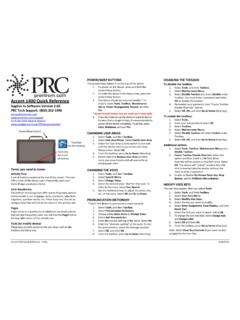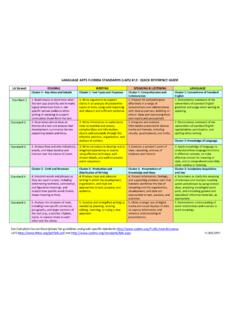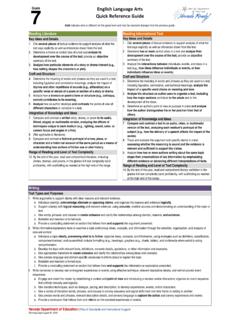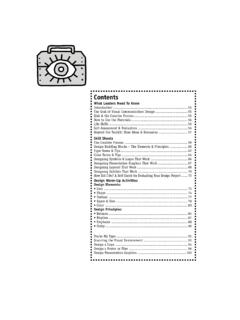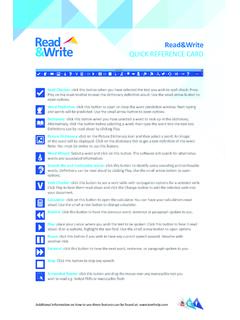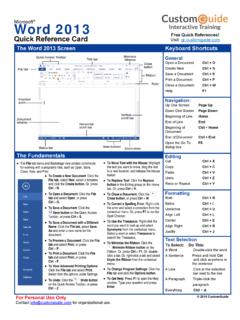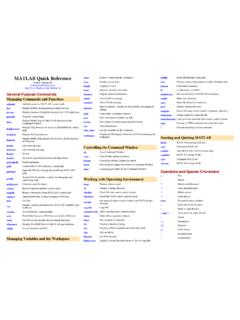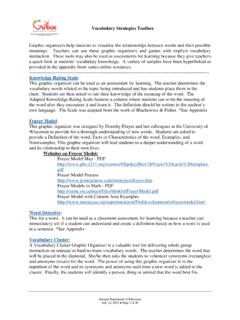Transcription of FOURTH GRADE READING LANGUAGE ARTS COMMON CORE …
1 FOURTH GRADE READING LANGUAGE ARTS COMMON CORE STATE standards quick reference Sheets janet s iTools for Schools [ ] Page 1 of 2 Educational materials designed to support in the implementation of the COMMON Core State standards - Copyright 2010. National Governors Association Center for Best Practices and Council of Chief State School Officers. All rights reserved. READING standards for LITERATURE Refer to details & examples in text when explaining what says explicitly & when drawing inferences Determine theme of story, drama, or poem from details in text; summarize Describe in depth a character, setting, or event in story or drama, drawing on specific details in text Determine meaning of words & phrases as used in a text Explain major differences between poems, drama, & prose, & refer to structural elements Compare & contrast point of view from which different stories are narrated Make connections between text of story or drama & visual or oral presentation of the text (Not applicable to literature) Compare & contrast treatment of similar themes & topics in literature from different cultures Read & comprehend literature in grades 4-5 text complexity band proficiently READING standards for INFORMATIONAL TEXT Refer to details & examples in text when explaining what text says explicitly & when drawing inferences Determine the main idea of a text and explain how it is supported by key details; summarize the text.
2 Explain events, procedures, idea, or concepts in historical, scientific, or technical text Determine meaning of academic & domain-specific words or phrases in text relevant to GRADE 4 topic Describe the overall structure of events, ideas, concepts, or information in text or part of a text Compare & contrast first- & secondhand account of same event or topic; focus & information Interpret information presented visually, orally, or quantitatively; how contributes to understanding Explain how an author uses reasons and evidence to support particular points in a text Integrate information from two texts on same topic to write or speak about subject knowledgeably Read & comprehend informational texts in grades 4-5 text complexity band proficiency READING standards : FOUNDATIONAL SKILLS Know and apply GRADE -level phonics and word analysis skills in decoding words Use combined knowledge of letter-sound correspondences, syllabication patterns, & morphology Read with sufficient accuracy and fluency to support comprehension Read on-level text with purpose and understanding Read on-level prose & poetry orally with accuracy, appropriate rate, & expression on successive readings Use context to confirm or self-correct word recognition and understanding, rereading as necessary WRITING standards Write opinion pieces on topics or texts, supporting a point of view with reasons and information Introduce topic or text clearly, state opinion.
3 & create structure with ideas grouped to support purpose Provide reasons that are supported by facts and details Link opinion and reasons using words and phrases Provide a concluding statement or section related to the opinion presented Write informative/explanatory texts to examine a topic and convey ideas and information clearly Introduce topic clearly & group paragraphs & sections; formatting, illustrations, & multimedia Develop topic with facts, definitions, details, quotations, or other information & examples related to topic Link ideas within categories of information using words and phrases Use precise LANGUAGE and domain-specific vocabulary to inform about or explain the topic Provide a concluding statement or section related to the information or explanation presented Write narratives to develop real or imagined experiences or events using effective technique Orient reader by establishing situation & introducing narrator &/or characters.
4 Sequence unfolds naturally Use dialogue & description to develop experiences & events or show responses of characters to situations Use a variety of transitional words and phrases to manage the sequence of events Use concrete words and phrases and sensory details to convey experiences and events precisely Provide a conclusion that follows from the narrated experiences or events Produce clear & coherent writing; development & organization appropriate to task, purpose, & audience Develop & strengthen writing as needed by planning, revising, and editing Use technology to produce & publish writing & interact & collaborate with others; keyboarding skills-1 page Conduct short research projects that build knowledge through investigation of different aspects of a topic Recall information from experiences or gather from print & digital sources; notes & list sources Draw evidence from literary or informational texts to support analysis, reflection, and research Apply GRADE 4 READING standards to literature Apply GRADE 4 READING standards to informational texts Write routinely over extended & shorter time frames for discipline-specific tasks, purposes, & audiences FOURTH GRADE READING LANGUAGE ARTS COMMON CORE STATE standards quick reference Sheets janet s iTools for Schools [ ] Page 2 of 2 Educational materials designed to support in the implementation of the COMMON Core State standards - Copyright 2010.
5 National Governors Association Center for Best Practices and Council of Chief State School Officers. All rights reserved. SPEAKING & LISTENING standards S& Engage effectively in range of collaborative discussions with diverse partners on GRADE 4 topics and texts S& Come to discussions prepared, having read or studied required material; draw on to explore ideas S& Follow agreed-upon rules for discussions and carry out assigned roles S& Pose & respond to specific questions to clarify or follow up; comments that contribute to discussion S& Review key ideas expressed & explain their own ideas and understanding in light of the discussion S& Paraphrase portions of text read aloud or information presented in diverse media & formats S& Identify the reasons and evidence a speaker provides to support particular points S& Report on topic, tell story, or recount experience in organized manner; speak clearly; understandable pace S& Add audio recordings & visual displays to presentations to enhance main ideas or themes S& Differentiate between contexts that call for formal English & where informal discourse is appropriate LANGUAGE standards Demonstrate command of conventions of standard English grammar and usage when writing or speaking Use relative pronouns (who, whose, whom, which, that) and relative adverbs (where, when, why) Form and use the progressive ( , I was walking; I am walking; I will be walking) verb tenses Use modal auxiliaries ( , can, may, must) to convey various conditions Order adjectives within sentences according to conventional patterns Form and use prepositional phrases Produce complete sentences, recognizing and correcting inappropriate fragments and run-ons.
6 * Correctly use frequently confused words ( , to, too, two; there, their).* Demonstrate command of conventions of standard English capitalization, punctuation, & spelling when writing Use correct capitalization Use commas and quotation marks to mark direct speech and quotations from a text Use a comma before a coordinating conjunction in a compound sentence Spell GRADE -appropriate words correctly, consulting references as needed Use knowledge of LANGUAGE and its conventions when writing, speaking, READING , or listening Choose words and phrases to convey ideas precisely.* Choose punctuation for effect.* Differentiate between contexts that call for formal English & where informal discourse is appropriate Determine or clarify meaning of unknown & multiple-meaning words & phrases, GRADE 4 READING & content Use context ( , definitions, examples, or restatements in text) as a clue to the meaning of a word or phrase Use COMMON , GRADE -appropriate Greek and Latin affixes and roots as clues to the meaning of a word Consult reference materials, print & digital, to find pronunciation & determine or clarify precise meaning Demonstrate understanding of figurative LANGUAGE , word relationships, and nuances in word meanings Explain the meaning of simple similes and metaphors ( , as pretty as a picture) in context Recognize and explain the meaning of COMMON idioms, adages, and proverbs Demonstrate understanding of words by relating them to their (antonyms) & (synonyms)
7 Acquire & use GRADE -appropriate academic & domain-specific words & phrases
